
NHPRC News - March 2010
NHPRC News
March 2010
In This Issue:
Inside the Commission
NHPRC and Open Government
For the past several months, the National Archives has been working on the Open Government Initiative. In December 2009, the Obama Administration issued guidance to promote new lines of communication and cooperation between the Federal government and the American people through the principles of transparency, participation, and collaboration.
We are working through the mechanisms at the National Archives to embrace these goals and principles, and we will release a first draft of our plan on April 6. At the heart of the plan is a flagship initiative to develop web and data services that are useful to the American people. This includes:
- a redesigned archives.gov website that is simplified and inclusive of user communities
- an easy, streamlined online public access experience that unlocks electronic and digitized records from sources across the agency
- a strategic approach to digitization at NARA
- social media tools leveraged to accomplish our goals within all sectors of the agency
- an inventory of data sets
- an updated FOIA Electronic Reading Room
- an updated records management website that will be an example for records management throughout the federal government
To ensure that the work of the NHPRC is part of Open Government, the Commission has launched a facebook page and on it and this site, we will include notices for all our public meetings and related materials. We encourage your feedback for other Open Government Initiatives. Please feel free to send your ideas to keith.donohue@nara.gov.
Grant Deadlines
The following Grant opportunities are currently available online:
-
Digitizing Historical Records
Final Deadline: June 3, 2010 -
Electronic Records Projects
Final Deadline: June 3, 2010 -
Professional Development Grants
Final Deadline: June 3, 2010 -
Publishing Historical Records: Colonial and Early National Period
Final Deadline: June 3, 2010 -
Strategies and Tools
Final Deadline: June 3, 2010
Go to Grant Opportunities for more information.
News from our Grantees
Uncovering Hidden Los Angeles
Thanks to a recent grant from the NHPRC, University of Southern California librarians are creating online finding aids for 53 archival collections related to Los Angeles arts and culture, including the papers of Ray Bradbury. You can see the results of their work by searching the libraries' HOMER catalog or visiting the Online Archive of California Web site, where you can view detailed descriptions of 7 newly processed collections of L.A. historical materials.
The previously hidden collections include: Abolish Cross-Filing in California Records, the Caltrans District 7 Collection, the Gladwyn Hill Kennedy Assassinations Investigation Papers, the John A. Sanborn Papers, the Robert Richardson Southern California Theater Collection, The Scribes Records, and 1984 Los Angeles Olympics Collection. In addition, USC librarians recently processed additional collections of rare archival materials related to L.A. history: the David Rose Papers, the Del M. Reynolds Papers, and the J.E. Woodhead Papers.
These unique collections will soon become more accessible to scholars thanks to the USC Libraries' summer 2009 grant from the NHPRC, which awarded the libraries $110,560 to arrange and describe 53 collections, including the papers of Irving Wallace and a variety of important film and performing arts archives. The materials complement the archival collections of L.A. and California-related materials selected for two processing projects that were recently awarded Hidden Special Collections and Archives grants by the Council on Library and Information Resources (CLIR).
Rudy Wendelin at the Forest History Society
The staff at the Forest History Society in North Carolina recently completed an NHPRC grant to preserve and provide scholarly access to their archives. The collection includes the papers of renowned artist Rudolf Wendelin (1910-2000), who imagined and brought famed US Forestry Service spokesman "Smokey the Bear" to life.
Amanda Ross of the Forest History Society put together an abbreviated timeline and just a few of the Smokey Bear-related items present in the archival and photographic collections.
1942 - The U.S. entry into World War II following the 1941 attack on Pearl Harbor made America keenly aware of the vulnerability of U.S. soil and left the homefront bereft of experienced firefighters, many of whom joined the armed forces. Protection of the country's forests became a national security matter. With the help of the War Advertising Council, the Forest Service organized the Cooperative Forest Fire Prevention (CFFP) Program with the National Association of State Foresters and launched a fire prevention campaign.
1944 - The War Advertising Council produced a promotional poster featuring Walt Disney's Bambi, proving successful with animal messengers.
1944-1945 - The Forest Service and War Advertising Council introduced a bear as the campaign symbol. Illustrator Albert Staehle rendered the forest fire prevention bear, who was given the moniker "Smokey Bear."
1946 - Forest Service artist Rudy Wendelin developed Smokey Bear artwork for special events, publications, and licensed products. Under Wendelin's direction, Smokey assumed the more humanesque form by which he is best known: wearing a solemn expression, ranger's hat and jeans, and carrying a shovel.
1950 - A burned bear cub survived the Capitan Gap fire in New Mexico's Lincoln National Forest and was cared for by New Mexico Game Warden Ray Bell. The live cub, dubbed "Smokey Bear," was donated to the National Zoo in Washington, D.C., where he remained until his death in 1976.
1964 - At one point, Smokey had four secretaries to answer his mail - nearly a thousand letters a day! So popular was the bear that in 1964, the U.S. Postal Service issued him his own zip code (20252).
1979 - The Smokey Bear Historical Park in Capitan opened to the public.
1984 - Rudy Wendelin designed the commemorative Smokey Bear stamp, with its first day of issue on August 13, 1984.
2008-2009 - The Forest Service, National Association of State Foresters, and Advertising Council launched a new round of Public Service Announcements featuring Smokey Bear along with a redesigned web site and new tagline ("Get Your Smokey On").
Wendelin was also the artist for the Woodsy Owl character, created by Harold Bell, as an anti-pollution mascot.
Less well known is Wendelin's renderings of "Raindrop," a spritely character drawn to encourage and promote water conservation.
A finding aid to the Rudolph Wendelin papers is available at the The Forest History Society. To learn more about the Forest History Society and its collections, visit their award-winning blog Peeling Back the Bark.
New Guide to Distributed Digital Preservation
Supported with a grant from the NHPRC, the MetaArchive Cooperative provides low-cost, high-impact preservation services to help ensure the long-term accessibility of the digital assets of universities, libraries, museums, and other cultural heritage institutions. Its new publication, A Guide to Distributed Digital Preservation edited by K. Skinner and M. Schultz, is the first of a series of volumes describing successful collaborative strategies and articulating specific new models that may help cultural memory organizations work together for their mutual benefit.
This volume is devoted to the broad topic of distributed digital preservation, a still-emerging field of practice for the cultural memory arena. Replication and distribution hold out the promise of indefinite preservation of materials without degradation, but establishing effective organizational and technical processes to enable this form of digital preservation is daunting. Institutions need practical examples of how this task can be accomplished in manageable, low-cost ways.
Written with a broad audience in mind that includes librarians, archivists, scholars, curators, technologists, lawyers, and administrators, the guide provides both a philosophical and practical understanding of the emerging field of distributed digital preservation, including how to establish or join a network.
The MetaArchive Cooperative currently is comprised of the following members: Auburn University, Boston College, Clemson University, Emory University, Florida State University, Folger Shakespeare Library, Georgia Tech, Library of Congress, Penn State University, Pontifícia Universidade Católica do Rio de Janeiro, Rice University, University of Louisville, University of Hull, University of North Texas, University of South Carolina, and Virginia Tech.
The American Record
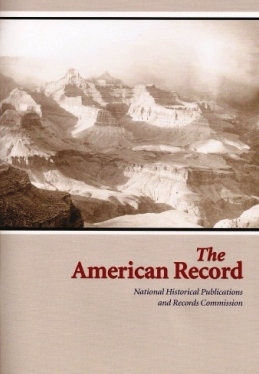
A new print publication, The American Record, is now available from the NHPRC. Two dozen grantees are profiled in this 54-page booklet, a small fraction of the successful projects supported since 1964. If you would like a hard copy, send an email with The American Record in the subject, along with your mailing address to keith.donohue@nara.gov.
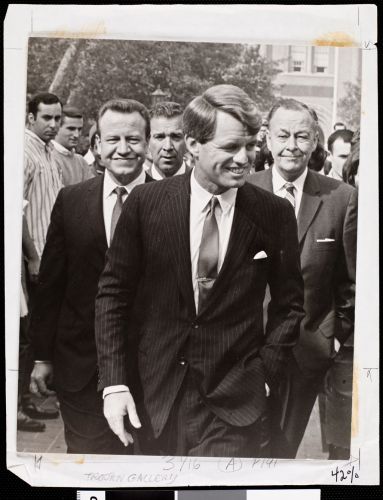 Robert F. Kennedy with California Assembly Speaker Jesse Unruh (left) and former USC President Norman Topping (right) during a 1965 visit to campus. Photo courtesy USC Archives.
Robert F. Kennedy with California Assembly Speaker Jesse Unruh (left) and former USC President Norman Topping (right) during a 1965 visit to campus. Photo courtesy USC Archives.
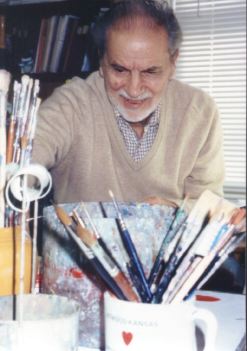 Rudolf Wendelin (1910-2000)
Rudolf Wendelin (1910-2000)
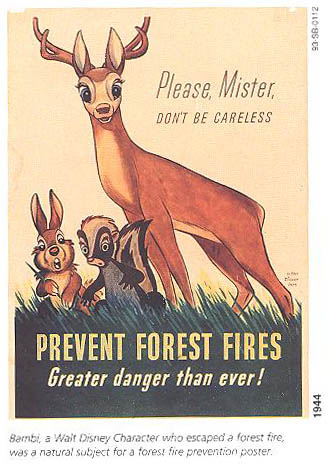 Bambi, a Walt Disney Character who escaped a forest fire, was a natural subject for a forest fire prevention poster. (1944)
Bambi, a Walt Disney Character who escaped a forest fire, was a natural subject for a forest fire prevention poster. (1944)
 Staehle s art for the first 2 years showed Smokey Bear already actively engaged in the business of forest fire prevention. (1944)
Staehle s art for the first 2 years showed Smokey Bear already actively engaged in the business of forest fire prevention. (1944)
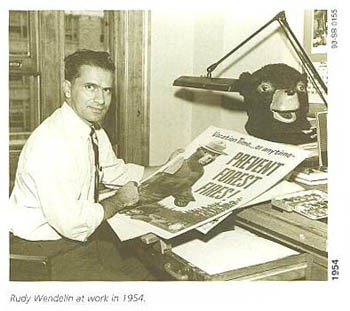 Rudy Wendelin at work. (1954)
Rudy Wendelin at work. (1954)
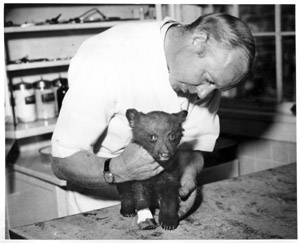 A burned bear cub was dubbed Smokey Bear, and donated to the National Zoo in Washington, D.C.
A burned bear cub was dubbed Smokey Bear, and donated to the National Zoo in Washington, D.C.
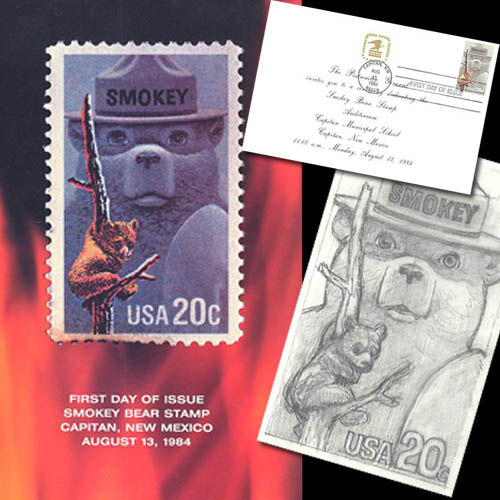 Commemorative Smokey Bear stamp was designed by Rudy Wendelin. (1984)
Commemorative Smokey Bear stamp was designed by Rudy Wendelin. (1984)
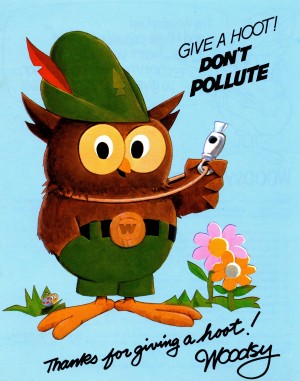 Woodsy Owl, an anti-pollution mascot..
Woodsy Owl, an anti-pollution mascot..
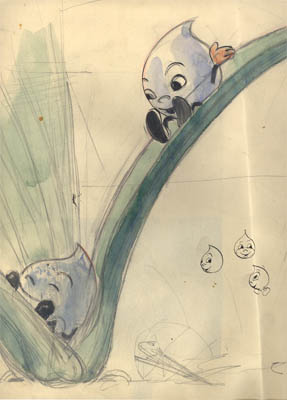 Raindrop drawn to encourage and promote water conservation.
Raindrop drawn to encourage and promote water conservation.